Occult Psychology
GA 183
Lecture II
18 August 1918, Dornach
Today I should like to start by giving a kind of sketch of the human soul, as this human soul stands in relation to the world and to itself. I should like to give this sketch in such a way that it can be said: we are looking at the profile of man as a soul being. So that we understand ourselves just as if we were to look at the physical man—not the soul-being (see Head in diagram 1)—not perhaps seeing him full-face but, let us say, from the right in profile. Let us observe him thus. If we try to sketch in outline anything like this we must naturally always keep in mind that we have to do with imaginative knowledge, that the reality behind the matter therefore is being given in picture form. The picture refers to the matter and is given, too, in such a way that it correctly indicates the matter. Naturally, however, we may not have the same idea of a drawing, a sketch, meant to represent something of a soul and spirit nature as we do of anything that in a naturalistic way is copied from an external perceptible reality. One must be conscious all the time of what I am now saying. I shall therefore omit all that concerns the physical and lower etheric organism of man and try to sketch only what is soul—soul-and-spirit (see diagram 2). As you know from the various descriptions that have been given, the soul-and-spirit stands in a more direct connection with the world of soul-and-spirit than physical man stands in connection with his physical environment. Towards his physical perceptible environment physical man is rather an isolated being; one might even say that physical man of the senses is really shut up within his actual skin.
It is not so where what can be called the men of soul-and-spirit is concerned. There we have to think of a continual crossing of the currents pulsating in the inner depths of man's soul-and-spirit—of all the movements and currents existing in the general, universal world of soul-and-spirit.
If I want first of all to describe from the one side the kind of relation the human soul-and-spirit has to what is of soul-and-spirit in the cosmic environment, I should have perhaps to do it in this way. I should, first of all, have to paint what enters in a soul-spiritual way from the universal, from the infinity of space, like this. Naturally I should have to paint the whole space in a way... but that is not really necessary. I shall only paint man's immediate environment. Thus it is now what we may understand as the surrounding world. (see blue in diagram 2).
Now imagine in this picture form of the soul-spiritual that into which man is placed. Man indeed is not yet there, but indicated in this blue is only the edge of the environment. Imagine this like a surging blue sea filling space. (When I say ‘blue’ sea this must naturally be taken as I have often described it in books available to you, namely, colours are to be grasped in the description of the aura, of the soul-spiritual.) Borne like a wave, swimming, I might say, or hovering, so nothing else is borne up which is of soul-and-spirit. This is what I should now have to represent perhaps in the following way.
Thus, if we pass from the cosmic environment to man, we may be able to think of ourselves and what belongs to the human spirit-and-soul as perhaps hovering in this red.
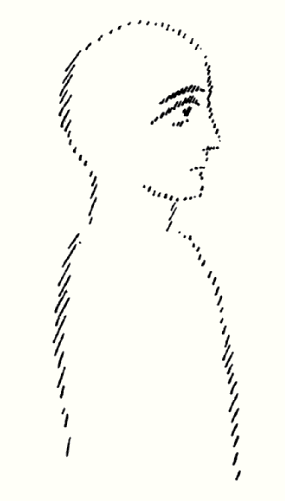
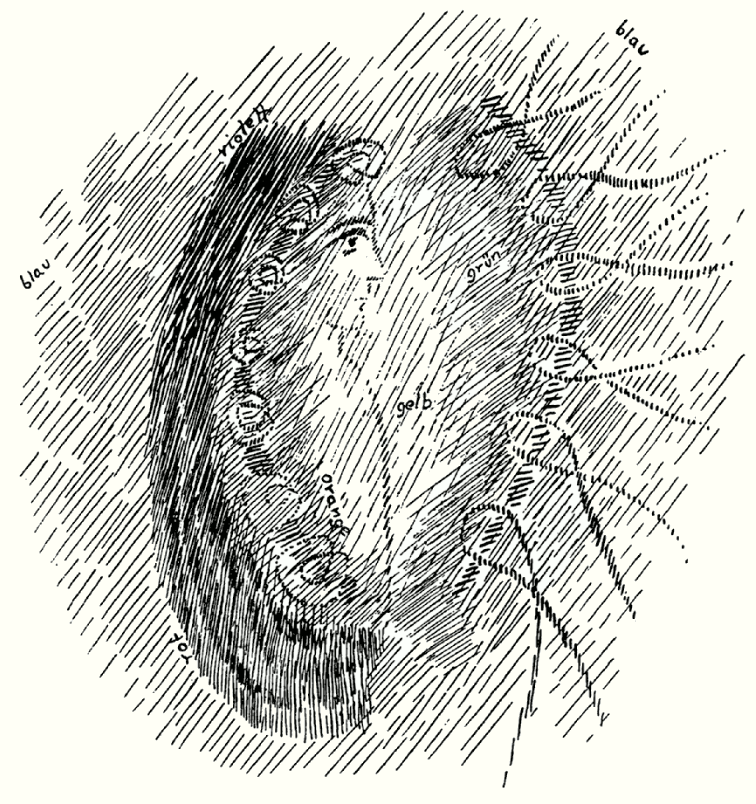
There we should have first of all part of the soul-spiritual; and if we would make the sketch in accordance with reality it is only the upper part we should have to give in a kind of violet, in lilac graduating into red. This could only be given correctly by toning down the red into violet.
Thus, you see, with this I have given you first what might be called the one pole of man's spirit-and-soul nature. We get the other pole when we can perhaps incorporate in the following way what, adjoining the universal soul-spiritual here, is swimming and hovering towards the human physical face: yellow, green, orange; green running into the blue.
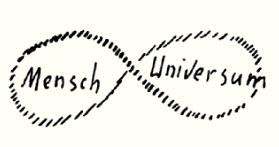
Here you get from the right side what I might call the side view of the normal aura of man. I say expressly a normal aura seen from the right side. What is presented to the view in this figure shows how man is placed into his environment of soul-and-spirit. But t also describes where man, the soul-and-spirit in man, stands in relation to itself. When everything represented by this figure is studied, it can clearly be seen how man is a being bounded an two sides. These two sides where man has his limits are always observed in life; but they are not indicated correctly nor considered in the right way—at least they are not understood. You know how in external science it is said that when man observes the world, when with his science he wishes to gain knowledge of the world, he comes to definite limits. We have often spoken of these limits, of the famous ignorabimus (“we shall never know”) which holds good with scientists and many philosophers. It is said that man comes indeed to certain limits in his cognition, in his conception, of the external world. I have certainly already quoted to you du Bois-Reymond's famous statement that in his seventieth year he made to the Scientific Congress in Leipzig; Human cognition will never penetrate into the regions haunted by matter—this is roughly what he said at the time. Perhaps the more correct way of speaking about the limits to human knowledge would be the following. In observing the world it is necessary for man to hold fast certain concepts which he penetrates neither with his scientific cognition nor with his ordinary philosophical cognition, we need only consider such concepts as that of the atom. The atom, however naturally has meaning only when we cannot actually speak of it, when we cannot say what it is. For the moment we were to begin describing the atom, it would no—longer be an atom. It is simply something unapproachable. And it is thus already matter, actual substance. Certain concepts have to be maintained that can never be approached. It is the same with knowledge of the external world; inaccessible concepts like matter, force and so on, must be maintained. That they should have to be maintained, depends here simply upon the inner light of man's soul-and-spirit stretching out into the darkness. What is stated to be the limit of knowledge can, I might say, actually be seen clearly in the aura.
Here lies a boundary in front of man. His being, what he himself is, is here represented in the aura by what I nave made run from bright green into blue violet (see diagram 2). But by passing over into blue-violet it leaves off being man and becomes the encircling cosmos. There with his being, which is the inner force of his world outlook, man comes to a boundary; there in a sense he reaches nothingness and he has to hold fast to concepts having no content—concepts such as matter, atom, substance, force. This lies in the human organization, it lies in man's connection with the whole cosmos. Man's connection with the whole cosmos actually stands out in front of him. If we describe this boundary in accordance with the ideas of spiritual science, we can do so by saying (diagram 3): this boundary allows man with his soul to come into contact with the universe. If we indicate the direction of the universe in one loop of a lemniscate we can with the other loop show what belongs to man, only what proceeds from man goes out into the universe, into the infinite.
Therefore we must make the line of the loop, the lemniscate, open on one side, closed on the other, and draw it like this—here the line of the loop is closed and here it goes out into infinity. It is the same line that I drew there, only here the arm goes out at this end into infinity (see diagram 4 of lemniscate open to the outside). What I have here drawn as an open lemniscate, as an open loop, is not just something thought out, but something you can actually look upon as flashing in and out of a gentle, very slow movement as the expression of man's relation to the universe. The currents of the universe continually approach man; he draws them towards him, they become intermingled in his vicinity and proceed outward again. Thus this kind of thing streams towards man, interweaves and then goes out again; man is permeated by these currents belonging to the universe, which stop short in front of him.
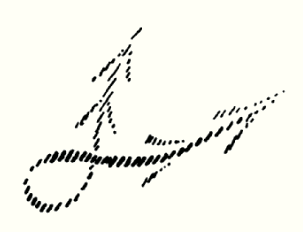
As you may imagine, through this man is surrounded by a kind of wave-like aura; these currents enter from the universe, form a whirlpool here, and by making this whirlpool in front of him, as it were, salute man. So that here he is surrounded by a kind of auric stream.
This is essentially an expression of man's relation to the cosmos, to the surrounding world of soul-and-spirit. You can, however, find all that you actually experience as lying in your consciousness represented here as a mixture of blue, green and yellow running into orange towards the inside. But that pushes up against here; within the soul part of man this yellow-orange collides with what waves on the blue sea as the soul-and-spirit of the lower man, of the man below. What I have shown here in red passing into orange, belongs to the subconscious part of man, and corresponds to those processes in the physical that take place principally in the activity of the digestion and so forth, where consciousness plays no part. What is connected with the consciousness would be described, where the aura is concerned, in the bright parts that I have applied here. (see diagram 2)
Just as here the soul-spiritual of man meets the soul-spiritual of the surrounding world, so what is within man as his soul and spirit meets his subconscious—that actually also belongs to the universe. I shall have to draw this meeting of the currents so that one of the streams goes out into the infinite; within man I must draw this meeting differently. Here I must also draw a loop line but this must be done so that it runs towards the inside. Now please notice that I am keeping entirely to a looped line but I take the under loop and turn it around so that it goes thus (diagram 6).
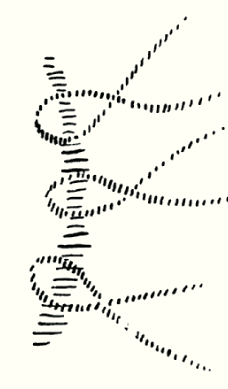
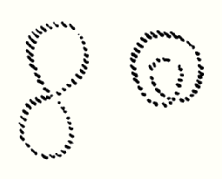
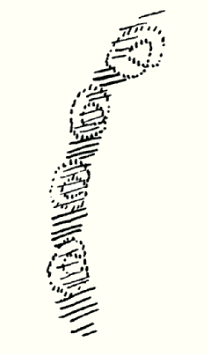
Thus, I turn the lower loop around. In contrast to the above diagram 5, where I have made one loop run out to infinity, widen out into the infinite, I now turn back the lower loop; with this I have shown diagrammatically the obstacles, dams, that arise where the spirit and soul here in the inside enter the subconscious spirit-and-soul and therefore also that of the cosmos.
I must therefore describe these obstacles if I draw them as corresponding to what arises in man, in the following way; seven lemniscates with turned back loops—those are the obstacles that correspond to an inner wave in man (diagram 7). If you wish actually to follow up this inner wave, its main direction—but only its main direction—would perhaps take the course of running along beside the junction of man's wrongly named but so-called sensory and motor nerves. This is only said by the way for today I am going to describe the matter chiefly in its soul-spiritual aspect.
By this you can see the strong contrast existing in man's relation to the spirit and soul environment and to himself, namely, to that bit he takes in out of the spirit-soul environment as his subconscious, and what I have had to sketch as the red wave swimming on the universal blue sea of the spirit-soul universe.
We said that this wave here (see right of diagram 2) corresponds to the barrier against which man pushes if he wishes to know about the external world. But there is a limit here too (see left of diagram 2); within men himself there is a barrier. Did this limit, this barrier, not exist you would always be looking down into what is within you, my dear friends. Everyone would look within himself. In the same way that man would look into the external world were the barrier (on the right) not there, if the boundary on the left were not present he would look into himself. If man looked into himself in this present cycle of evolution this would indeed give him little joy, because what he would see there would be a most imperfect, chaotic seething upheaval in man's inner nature—something that certainly could not arouse joy in him. It is, however, that into which imaginative mystics believe they are able to link when they speak of the mysticism that is full of fantasy. All that the mystics of fantasy very largely look upon as a goal worthy of their striving, what, particularly in the case of many such mystics who really believe that in looking within themselves they are able to learn about the universe, what figures with them as mysticism—all that is concealed, entirely concealed, from men by just this dam.1Mysterien Wahrheiten und Weihnachtsimpulse. 6 Lectures 24-31, December 1917. (Mystery Truths and the Christmas Impulse), 4 lectures in Magazine, 24-29)
Man cannot look into himself. what is formed inside this region (left) is dammed up and reflected, it can t be reflected back into itself; and the expression of this, reflection is memory—remembrance. Every time a thought or an impression that you have received comes back in memory it does so because this damming process begins to work. If you had not this stemming wave, every impression received from outside, every thought you grasp and which permeates you, would be unable to remain with you and would go out into the rest of the soul-spiritual universe. It is only because you have this obstructing wave that you can preserve the impressions you receive.
Through certain processes still to be described you are in a position to call back your impressions. And this is expressed in the functioning of recollection, of memory. You can therefore picture to yourself that you have in you something that here in this diagram is drawn in profile (for so it is drawn; there is in you just such a flat surface); There we find thrown back what should not penetrate. When you are awake you remain united with the external world, otherwise in the waking condition everything would go through you. You would actually know nothing of impressions; you would nave impressions but be unable to keep them.
This is what memory signifies. And the surface of this dam that brings about our memory conceals what the imaginative mystic would like to look at, within himself. One could say of what is underneath that for those who really know these things, the saying holds good that man should never be curious to see what the beneficent Godhead has covered with night and obscurity, but the mystics are fantastic and wish to look down into it. All the same, they cannot do so, however, for they would so bore into and destroy the normal consciousness that the waves of memory would not be thrown back. All that produces our memory, all that is so necessary for external life, conceals from us what the fantastic mystic would like to see but men should not look upon. Beneath recollection, beneath what causes recollection, beneath the surface of recollection, lies an essential part of man. Just like the back of a mirror, the mercury being a mirror, what is in front, what is thus in your consciousness works; it does not go inside but is thrown back and is therefore able to continue there as memory. In this way our whole life is reflected as a memory. And what we call the life of our ego is essentially reflection in memory.
Thus you see that we actually live our conscious life between this wave (right of Diagram 2) and this other wave (left). We should be mere funnels, therefore, letting everything flow through us; had we not this dam as the basis of memory, and we should see into the secrets beyond our boundary of knowledge were we not obliged to place ourselves outside the sphere of perceptible concepts for which we have no content. We should be funnels were we not so organised that we could not produce this dam, organised so that we should not be obliged to set up before us concepts as it were without a content, obscure concepts, we should become loveless beings, empty of love, with dry, stony natures. Nothing, in the world would please us and we should be so many Mephistopheles. Because we are organised so that we are unable to approach what is of soul-and-spirit in our environment with our abstract concepts, with our intellectual powers—to this we owe our capacity to love. For we are not meant to approach what we should love by analysing it in the ordinary sense of the term, nor by tearing it to pieces and treating it as chemicals are treated by the chemist in a laboratory. We do not love when we analyse like a chemist or synthesise chemically. The power of memory, the capacity to love—these are two capacities that correspond at the same time to two boundaries of human nature. The boundary towards within, corresponds to the power of memory; what lies beyond the memory zone is the subconscious within man. The other zone corresponds to the power of love, and whet lies beyond this zone corresponds to what is of the nature of soul-and-spirit in the universe. The unconscious part of man's nature lies beyond this zone as far as what is within man reaches; the soul-spiritual of the universe goes out boundlessly from the other zone into the wide space.
We can therefore speak of the zone of love and the zone of memory and can include man's soul-and-spirit in these zones. We must however seek beyond the one zone above (see right of diagram 2) whet is unconscious, and because it remains unconscious is on that account very closely connected with the bodily nature of man, with his bodily organisation. Naturally things are not in reality so simple as they must be in any representation, because everything is interwoven. What is red here (diagram 2) runs into things and is changed; again, what is green and blue is also changed. Actually, things all intermix with one another: in spite of this, however, the sketch is correct in the main and corresponds with the facts.
But from this we see that for physical life here on earth the spiritual is both strong and conscious. Here (left) the spiritual that actually merges into the universe is unconscious. These two parts of man are very clearly differentiated. The spiritual here (in the middle) is for this reason above all for earthly life a very finely woven spiritual element. Everything here (yellow) is what might be called finely woven light. Were I obliged to show where this finely woven light is in man, I should have to go to what I have been so minutely describing—the human head.
What I have thus described, what I have sketched in yellow, yellow-green, yellow-orange, on the other side, is what I might cell the finely woven spirit light. This has no very strong connection with earthly matter; it has as little connection with earthly matter as is possible. And because it has so little connection it cannot well unite with matter, and thus, for the greater part, remains unconnected with it; to this part matter is given that actually always comes from time to time from man's previous incarnation, and there is but a loose connection between this finely woven soul-spiritual element and what belongs to the body, what has actually been held together out of the foregoing incarnation. Your physiognomy, in its arrangement and characteristics, you carry over, my dear friends, from your previous incarnation. And those who are thoroughly able to explain man actually look through the physiognomy of the head; not through what has its origin in the luciferic within men, but more through the manner in which he adapts himself to the universe.
The physiognomy must be looked upon as though it were stamped into man, not to the extent of being the product of this stamping, but rather one has to see in it the negative of the soul; it is this that is seen in the negative of the face. If you were to make an impression of any face you would actually see there the physiognomy that relentlessly betrays what has been made of the last incarnation. On the other hand, all that I have sketched down there as being only connected with the surging sea of the world of soul and spirit, all that is to be understood as corresponding to man's subconscious or unconscious, is closely related to the bodily nature; it permeates the bodily nature. The bodily nature is united with the spiritual in such a way that the spiritual is wholly incapable of appearing as such.
For this reason were we to look down we should see this seething and merging of the spiritual and the bodily behind the threshold of memory. It is this that pares the head of the next incarnation and seeks to transform what will take definite material form only in the future and will not become head until the next incarnation. For man's head is something that outstrips his stage of development. The head in its development therefore—as you may remember from lectures previously held here—has actually come to an end by man's twenty-seventh, twenty-eighth year. (See NSL 122-123 Historical Necessity and Free Will and R-LII Ancient Myths and Their Meaning). In the form of the head there is already our development of man.
But, strange as it may seem, the rest of man is also a head only it is not so far advanced as the other head. If you picture to yourself a decapitated man, what remains is another head but at a more primitive stage. When further developed it become head, whereas what you have as the human head is the rest of the organism of a previous incarnation. If you picture what in your present organism is discarnated, free of the body, if you think away the head of your present organism, the organism that will become head in the next incarnation (and this organism is but an image, everything physical being an image of something spiritual), if you imagine the spiritual element of what in its external form has not yet appeared in man, then you see this in the Group in our luciferic figure—there you have it!
Now imagine compressed into the human head all the soul-spiritual that is merged into man, and held back in you from the head, all that forms a barrier, that is to say, which man cannot penetrate (see right in diagram 2); then man will not have the old dignified head that he ordinarily has; he will have a bony head, and will be altogether bony, like the figure of Ahriman in our Group. (see Der Baugedanke des Goetheanum.)
What I have here been explaining to you has not only great significance for understanding man, but also great significance for understanding what is going on spiritually in mankind's evolution. If we have not a fundamental comprehension of these things we shall never understand how Christianity and the Christ-impulse have entered human evolution. Neither shall we understand what part is played by the Catholic Church, what part is played by the Jesuits and similar currents, what functions belong to the East, what to the West, if all this cannot be considered in connection with these things.
I shall take upon myself to tell you something of these currents tomorrow, currents such as those of East and West, Jesuitism, and the tendency to put everything into terms of mathematics, which really can only be rightly understood if we take into consideration what lies at the basis of soul-spiritual man.

